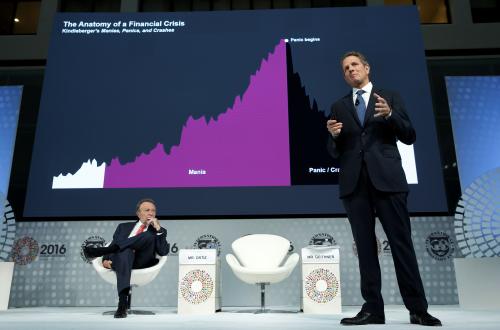This blog is part of a three part series that discusses the safety of the U.S. economy, global financial and economic risk, and global crisis preparedness.
The years since the global financial crisis have seen a great deal of reform in global crisis preparedness and emergency response. But with the economic recovery strengthening, and some immediate risks apparently subsiding, efforts to further improve safety mechanisms may go onto the backburner.
However, legacy and new risks in key economies, combined with the inherent uncertainty and volatility of the international capital flows, mean the international community should continue to bolster system safety.
Reasonable firepower, more tools to draw on
Fund “surveillance”—the regular scrutiny of the global economy and individual countries—has been upgraded to focus more on financial linkages and spillovers between economies. This can play an important preventative role in identifying and correcting risks before they become serious. At the same time, preventative advice can only go so far in assuring safety—in part due to country policy choices, and the ever-present risk of “unknown unknowns.”
The tripling of the International Monetary Fund balance sheet to about $1 trillion is hence fundamental.
Actions in the past year have shored up these resources. In late 2015, the U.S. Congress agreed to appropriate new “quota” or equity to the fund, which allowed an increase to the IMF’s permanent resources. This hard fought agreement appears to be even more important with the passage of time. The international community has also recently agreed to provide additional borrowed resources for several years.
Bilateral swaps between central banks could also be an important source of liquidity.
While incomplete in coverage, other resources are available to complement the IMF’s balance sheet. Over $1 trillion is available in regional financing arrangements aimed at crisis mitigation. Bilateral swaps between central banks could also be an important source of liquidity.
There are also new lending methods. To complement traditional modes of support, the IMF has developed new “precautionary crisis” prevention tools. These provide countries with strong economic fundamentals, facing heightened vulnerability, with ready access to IMF resources in the event of external shocks (e.g., sudden capital outflows as a result of international events). The idea is to nip crises in the bud by quickly shoring up strong economies and bringing stability to the system. The arrangement in place for Mexico is potentially significant in current circumstances.
Reluctance to use tools, and gaps
These positive developments disguise some remaining weaknesses that reduce the safety net’s effectiveness. The most important is the reluctance of countries to make use it. It has been striking how few countries availed themselves of traditional or new lending instruments over the past year where strong commodity price falls and financial market volatility have combined to elevate risks.
On one level this is understandable. Fund support usually involves policy constraints that can be politically painful. Nevertheless, there appears to be a stigma associated with seeking IMF support beyond inherent factors. The policy priority is to do everything possible to encourage appropriate and prompt access to the safety net.
At heart this involves ensuring the IMF is a trusted partner, which in turn involves continued progress on a number of fronts. The key is performance—that IMF programs should achieve their goals with minimum social and economic disruption. Lessons from high profile examples of the past are well known and must be continuously applied.
Alongside “hard” governance reforms, the IMF needs to continue the patient work in recent years to strengthen relationships across its membership and with civil society and other stakeholders.
The IMF must also continue to act evenhandedly toward all members. And finally, and related to both points, the governance of the fund needs to continue to evolve to underpin its legitimacy. This means further changing voting weights and board seats to reflect the changes in economic weight. The recent reforms to governance unlocked by the U.S. ratification, while incomplete and overdue, were critical in supporting the global safety net. Alongside “hard” governance reforms, the IMF needs to continue the patient work in recent years to strengthen relationships across its membership and with civil society and other stakeholders.
Ongoing U.S. support for these principles and the broad reform agenda is critical for both U.S. interests and those of the global economy.
Is there enough flexibility to deal with the range of crisis events?
Are global emergency powers enough to meet the challenges of the current global economy? Are current tools and policies fit for the range of circumstances countries face in a crisis or incipient crisis? And, how well placed are we to handle larger regional or global shocks that threaten even strong economies?
The first issue is scale—are there sufficient resources? Given the size of large emerging economies, what looks like large firepower could quickly be under pressure in a serious economic or financial shock.
This places a high premium on different parts of the safety networking together, including improving the readiness and reliability of regional arrangements and their operational links with IMF programs. This is particularly important in East Asia where the $240 billion mutual swap arrangement known as CMIM (Chang Mai Initiative Multilateralization) has the potential to bring significant resources to the table, but is yet untested. Work between CMIM and the IMF to better understand how they will interact in a crisis is therefore important. The right range of IMF program tools need to be available to facilitate linkages between the IMF, regional, and bilateral support.
This work assumes more importance given the challenge of maintaining the IMF balance sheet at sufficient scale in the medium term. The significant borrowed resources currently available to the fund (around $500 billion) are temporary with deadlines in 4-6 years. Maintaining support for an appropriately sized IMF balance sheet, including in the U.S. and other large members, is therefore an important strategic priority, as is hedging against the possibility of bad outcomes.
The second issue is ability to move quickly to nip a crisis in the bud. The key resources here are the swap lines between the large advanced country central banks, which allow liquidity to be deployed quickly to prevent market dysfunction. However, actions since the crisis have limited the ability of the Fed to deploy widely these swaps. This could leave gaps with important emerging market economies and other economies in a disruptive market event. The flexible credit lines at the IMF are important in this regard but, as noted, have had limited take up, partially due to stigma.
New forms of fund liquidity and monitoring arrangements could provide resources or credibility to countries with strong fundamentals and possibly avoid the stigma costs of current approaches. While necessarily involving limited resources, these instruments could also assist with linking other parts of the safety net (by ensuring the IMF’s capability and credibility is brought to bear).
A third issue is whether the safety net retains the flexibility to act in the face of truly systemic event, to prevent a panic spreading. On the face value, the fund lost such discretion by removing the “systemic exemption” clause in early 2016, which allowed exceptional levels of IMF lending in situations where a country might not achieve sustainable debt levels with high probability, but nevertheless a default would risk broader dangerous contagion.
However, the new replacement policy retains considerable flexibility. It allows for a wider range of debt restructuring operations, including less disruptive reprofilings of claims. It also specifies that the IMF can still lend into such situations if the program goes some way to improving the country’s prospects of achieving sustainable debt levels, and if fund resources are complemented by those of other funding partners.
All the challenges point to the importance of ensuring a well‑resourced, effective, and legitimate IMF.
Again this suggests the importance of ensuring good linkages between elements of the safety net. In particular, it highlights the need for large systemic economies, such as the U.S., Europe, Japan, and China, to understand their role and interests in crisis responses. Only these economies have the resources to mitigate global risks in a truly systemic event.
Maintain the safety net while reducing risk
All the challenges point to the importance of ensuring a well‑resourced, effective, and legitimate IMF. They also point to building strong linkages between parts of the safety net to maximize available resources and hedge against bad developments.
But the safety net is just that. The other priority should be to reduce risks at the core of the global economy through addressing underlying economic vulnerabilities and rebuilding macroeconomic capacity. Now is a good time to further improve global economic safety, while the memories and lessons of the global financial crisis are still are still front-of-mind.





Commentary
Part III: Global financial resilience in a time of uncertainty
Global crisis response: Are global ‘Emergency powers’ adequate?
March 3, 2017